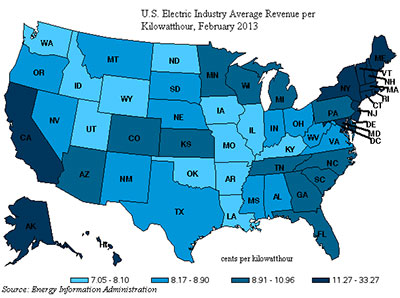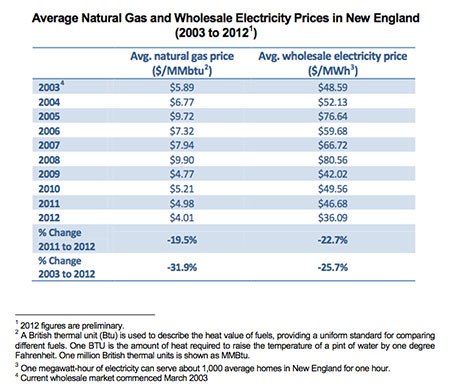Despite many benefits of locating businesses in New England such as proximity to a huge customer base, the relatively high cost of utilities can act as a damper to business growth, even if prices last year hit a record low.
“The Northeast does tend to have a higher cost of energy, and I don’t know the answer to that,” says Michael Bergeron, business manager for the New Hampshire Division of Economic Development.
“Utility costs are a challenge,” says Carmine Macchiagodena, general manager of a Structal-Bridges plan in Claremont, N.H. Strucal-Bridges is a division of Canam Group, which manufactures bridges, structural steel components, steel decks, and welded beams. Canam purchased the facility in 2007 in order to optimally serve the Mid-Atlantic market as well as Ontario and Quebec. “We are looking at renewable energy, including wind and solar,” says Macchiagodena.
“One drawback for us is that, while the northern two-thirds of the state has natural gas, we don’t have it available here in southern Vermont,” says Thomas Moffitt, CEO of Commonwealth Dairy, which opened a dairy in Brattleboro, Vt., in 2011. “As a result, we use propane, which isn’t particularly efficient. We do use electricity, but we’re not a huge user, so that’s not a big problem.”

Prices and purchased power were both way down in New England in 2012, but as this EIA map shows, that didn’t prevent a spike three months ago. Map courtesy of EIA
According to Lawrence Miller, secretary of the Agency of Commerce and Community Development for the State of Vermont, the state works to make sure that businesses have engineering support and financial support for improvement, so they can get their energy costs down as much as possible through efficiency and demand management.
“IBM, for example, which is our most important private employer in the state, has managed to trim its electric consumption an average of four percent a year for almost 15 years,” Miller says. “They are now using half the power per output that they did a decade ago.”
In addition, according to Miller, Vermont has long-term contracts with Hydro Quebec, so its power costing and availability will be very stable in the future.
“A lot of businesses in other states rely on natural gas,” he says. While natural gas prices are down, and the state doesn’t have a lot of natural gas, according to Miller, prices and availability in the future are not predictable.
Balancing Act
That unpredictability was at the core of testimony on March 19 by Gordon van Welie, president and CEO of grid operator ISO New England Inc., at a hearing called by the U.S. House Energy and Commerce Subcommittee on Energy and Power on the growing use of natural gas for electricity production. The hearing explored how the growing interdependency of the electric and gas sectors is leading to challenges to reliable power system operation.
New England is the poster child for a worrying trend, as more than half of the region’s power now comes from natural-gas-fired plants. “While this increase has brought economic benefits to New England consumers, including lower wholesale electricity prices and a significant reduction in pollutant emissions, the increased reliance on this fuel has created severe and immediate challenges to power system operations,” said an ISO New England release.
Year over year, the average price of wholesale electric energy fell 23 percent in 2012, from $46.68 per megawatt-hour (MWh) in 2011 to $36.09/MWh last year.
“New England has seen a dramatic shift in its generation fleet in a little more than 10 years, moving from a diverse mix of oil, coal, nuclear, and natural gas generation, to a system that is heavily dependent on natural gas to produce electricity,” said van Welie. “This shift has provided clear economic benefits for New England. The investment risk for new power plants has shifted to private investors, and electricity consumers in New England have benefited from the recent low prices in the natural gas market.”
Indeed, the ISO reported in January that the total amount paid for electric energy fell by more than a billion dollars in one year, from $6.7 billion in 2011 to approximately $5.2 billion in 2012, based on preliminary data. Just five years ago, in 2008, New England’s wholesale electric energy market value rose to a high of $12.1 billion, when natural gas prices soared to historic highs. Preliminary figures showed that, year over year, the average price of wholesale electric energy fell 23 percent in 2012, from $46.68 per megawatt-hour (MWh) in 2011 to $36.09/MWh last year.
But the risk to reliable grid operations is heightened during the winter, when there is a simultaneous demand for natural gas for both heating purposes and electricity generation. At times, this causes constraints on the natural gas supply coming into the region because there is not enough pipeline capacity to satisfy both heating and electric demand.
Hit by a double-whammy cold spell followed by Winter Storm Nemo this winter, the region saw wholesale electricity-energy prices increase more than 100 percent in January and more than 300 percent in February compared to 2012. During that period, said van Welie, “ISO operators had to cope with multiple instances where generators [both gas- and oil-fired] could not get fuel to run. Our experiences this winter lead us to conclude that the status quo is not sustainable. At one point during the winter storm, more than 6,000 megawatts of generation was unavailable due to uncertain fuel supplies or storm-related outages.”
Here’s the Plan
Companies that procure natural gas for heating purposes pay for and receive firm, priority contracts with the pipelines for natural gas delivery, but this can limit deliveries to some natural-gas-fired generators in the region, which typically do not pay for firm service and purchase their fuel using a just-in-time delivery system. The current wholesale electricity market design does not provide adequate incentives for generators to provide electrical energy when called on by the ISO during stressed conditions, in particular for gas generators who have not made adequate and reliable arrangements for fuel supply.
“Electricity supply and demand must be balanced on an instantaneous basis and problems on the electric system require immediate action, often through the operation of fast-responding gas generators,” said van Welie in March. “However, if generators have not contracted for gas prior to the electric operating day, the gas system may not be able to respond to the real-time, instantaneous demands of the electric system. This is particularly acute in New England, where the region has a significant reliance on ‘just in time’ interruptible fuel delivery and it is clear that the gas system is inadequate to meet the demands of electric generators during peak periods.
“When power plants do not have the fuel they need to operate it creates tremendous operational challenges and threatens reliability,” he testified. “We are seeing this on a more frequent basis, and we believe the status quo is unsustainable. For power-grid reliability to be maintained, we need to have adequate levels of fuel inventory within the region, either through storage or reliable transportation arrangements so that the electric sector is ready to respond whenever called on by the ISO. Those arrangements should be incentivized through changes to the wholesale electricity market design, so as to provide strong economic signals for generators to perform when needed. It is likely that this will result in incrementally higher wholesale prices in order to pay for the improved reliability that we seek.”
The six-state regional power system operated by ISO New England includes more than 350 generators and 8,000 miles of high-voltage transmission lines.
The region realized a nearly $7-billion reduction in wholesale electricity costs over the past five years as natural gas prices fell to those record lows in 2012. New England would benefit by using some of this savings to invest in infrastructure to expand the region’s access to low-priced natural gas, said van Welie, chiefly via pipelines connecting to shale-gas deposit territories to the immediate southwest, or to LNG terminals.

A downward trend in prices may appear promising, but can mask winter supply and demand challenges in the nation’s northeastern-most region.
“The region has historically relied on its oil and coal generation to provide fuel diversity and offset the operational risks associated with a constrained gas transportation system,” he said. “However, the confluence of low wholesale market prices [primarily caused by low natural gas prices], high oil prices [which limit the opportunities to profitably operate] and increasing environmental compliance costs is causing these generators to retire and/or limit the amount of fuel inventory that they carry. Thus, our dependence on gas generation is poised to increase and our operational options are becoming more limited.”
While market-based incentives appear to be one solution, “the region faces a regulatory conundrum,” said van Welie. “The natural gas generators generally have a short- to medium-term financial horizon and they are a diverse group with diverse market interests. Thus, they are a group of ‘fragmented buyers’ who are unlikely to enter into long-term fuel arrangements on a large scale. This does not align with the long-term commitment preferred by investors in gas pipelines and gas storage infrastructure.”
So ISO New England is working with the New England states and its stakeholders to develop market changes to provide the economic incentives necessary to ensure that generators have adequate and reliable fuel supplies. These include:
- Changes to wholesale markets to improve electricity price formation, improve the ability of generators to reflect the true cost of fuel in their offers to sell electricity, and strengthen performance incentives for generators and demand resources;
- Changes to the timing of the electricity market to provide additional time for generators to secure fuel from the gas market to meet their obligations in the electricity market, and to provide system operators additional time to call on non-gas-fired-generators if needed;
- Expanding the amount of resources held in reserve to respond to the sudden loss of generation due to a system contingency.
“Additional flexibility in the natural gas industry would also help address the challenges of increasing interdependency between the two industries,” said van Welie. “Power generation is rapidly becoming the largest customer for natural gas pipelines, and the gas sector could assist with reliability efforts if gas suppliers provided generators with additional opportunities to obtain fuel outside of normal business hours, and if pipelines would offer more flexible scheduling, additional services, and provide real-time information on the status of the pipeline system. In the long run, it would be helpful for the Federal Energy Regulatory Commission (FERC) to improve the operational alignment between the electric and gas systems.”
Playing the Self-Reliance Card
New England is the birthplace of “This Old House,” of course, and practically invented the do-it-yourself approach. One company that has partially taken utility costs into its own hands is Rutland Plywood Corp.
Founded in Rutland, Vt., in 1957, the company specializes in manufacturing hardwood plywood. In 2012, it expanded a wood-fired co-generation plant with the help of a $346,000 loan from the Vermont Economic Development Corp. The plant burns wood waste, which supplies steam to the mill and also to a steam-driven turbine and generator.
“The plant was really building on something that we have always done, which is use wood waste and other manufacturing scrap for fuel — using it to power the boilers to generate steam,” says Doug Babbitt, executive vice president. “In fact, we have designed our manufacturing process to work well with steam power. We use it for our dryers, to power our plywood presses, to heat the building, and so on.”
Expansion of the co-generation plant, of course, hinges on the availability of more fuel. That is, the company can’t expand the plant unless it ends up with more wood waste, and this is not a specific goal.
“It is always more profitable for us to make product and reduce waste as much as possible from the start, than it is to generate more wood waste to turn into steam,” says Babbitt.
